Tomorrow sees the first “proper” Shanghai derby in seven years as Shenhua take on newly promoted Shanghai East Asia – a match the local media are billing as the long-awaited return of a genuine Shanghai football rivalry. ‘s Cameron Wilson casts his mind back to his early days as a Shenhua fan and takes a look into the history of Chinese football’s original city derby. In a special extra-length feature, we uncover classic footballing tales of passion from over a decade ago when Inter Shanghai fought tooth and nail with Shenhua for the league championship in front of packed stadiums and raucous atmospheres.
The 90’s: The roots of time
The first ever Chinese top-flight city derby took place in 2002 when Shanghai Shenhua lost 2-0 to Shanghai Zhongyuan (later renamed Inter) in front of a sold out Hongkou Football Stadium. The clash was the opening act of what would be a rather short but intense chapter in the book of footballing rivalry, a period which would give rise to some of the most controversial moments in the sport in China.
Video: Some choice moments from Shanghai Derby history
The roots of the Shanghai derby stretch back to the mid 90s. Whilst Shanghai Shenhua were claiming their first, and to date only, league title in 1995, on the other side of the Huangpu river another club was quietly taking its first steps towards challenging Shenhua as the city’s top dog. Shanghai Pudong were formed in 1995, and would contest the first ever professional league match between two teams from Shanghai in the Chinese second division (known as Jia B at the time) in 1996. Their opponents were Shanghai Yuyuan, a short-lived club based at Jiangwan Stadium in Yangpu district. However, there was pretty much only one show in town during the 90s, as Shenhua enjoyed a “cool” reputation around this time and regularly packed out Hongkou stadium. It’s safe to assume there wasn’t much in the way of a derby atmosphere or many fans back in the day in the Chinese second division, and of course a derby is meaningless without fans, so the first bona fide Shanghai derby would only emerge when one these Shanghainese teams made to the Jia-A league, the precursor to today’s CSL.
2002: The rise of Inter Shanghai
This became a reality in 2002, when, following a series of promotions and name changes, the team formerly known as Shanghai Pudong entered China’s top division as Shanghai Zhongyan, before changing their alias once more, to Inter Shanghai, in 2003. Shanghainese football fans rubbed their hands with glee as the media looked forward to China’s first ever city derby. There are always plenty of obvious reasons to relish the prospect of a derby anywhere, even a relatively young one. But for Inter (then Shanghai Zhongyuan) these were not enough so the club decided to up the ante on their neighbours by trying to sell themselves as the most “Shanghainese” club in town. In an effort to win over local pride, they pursed a hugely controversial transfer policy, by signing Shenhua’s star players – Qi Hong and Shen Si – both Shanghai born and bred locals and hitherto heroes at Hongkou stadium. Not content with that, they also brought back Chinese footballing legend Fan Zhiyi, another Shanghainese player who had made his name at Shenhua before enjoying spells in the UK with Crystal Palace and Dundee. Adding to the somewhat incestuous mix between the clubs was the fact that Inter already had four Shanghai-born former Shenhua players on their books – Cheng Yaodong, Wu Bin, Yao Jun and Zhu Qi who had joined Inter whilst they were still in the second division. The Shanghai derby may have been just starting out, but no time had been wasted in implementing that most classic rivalry concept – that of familiarity breeding contempt.
Shanghai Derby results 2002-2013
2002
Shanghai Shenhua 0-2 Inter Shanghai
Inter Shanghai 3-0 Shanghai Shenhua
2003
Inter Shanghai 2-1 Shanghai Shenhua
Shanghai Shenhua 4-1 Inter Shanghai
2004
Inter Shanghai 1-1 Shanghai Shenhua
Shanghai Shenhua 3-2 Inter Shanghai
2005
Shanghai Shenhua 1-0 Inter Shanghai
Shanghai Zobon 1-0 Shanghai Shenhua
Shanghai Zobon 1-2 Inter Shanghai
Inter Shanghai 1-2 Shanghai Shenhua
Shanghai Shenhua 3-0 Shanghai Zobon
Inter Shanghai 3-0 Shanghai Zobon
2006
Shanghai Shenhua 0-0 Shanghai United
Shanghai United 1-1 Shanghai Shenhua
2012
Shanghai Shenhua 0-0 Shanghai Shenxin
Shanghai Shenxin 1-1 Shanghai Shenhua
2013
Shanghai Shenxin 0-1 Shanghai Shenhua
Shanghai Shenhua ? -? Shanghai East Asia
Matches refer to top division league games only
2003-2004: The smell of gunpowder
Big games in China are often described in the media using the term huoyao tong, best translated as “powder keg”. It would prove to be a fitting expression for the first ever “Shanghai Derby” on March 9, 2002 – as the coming together of two clubs dueling so publicly for local supremacy inevitably produced fireworks. Before the game it had emerged that, Xu Genbao, the then manager of Shanghai Shenhua, had motivated his players by belittling new Inter signing Fan Zhiyi, one of China’s most successful foreign exports, as a Kongxin luobo (hollow radish) – a Chinese idiom used to describe someone as useless. Xu, well-known for his colourful language and big personality, only succeeded in stirring up the opposition players. Shen Si, another former Shenhua player, scored the first goal in the derby and, in celebration, shocked viewers by shouting Xu Genbao’s name into the TV cameras whilst making a rude gesture. Shen’s outburst shocked the viewing public by contradicting the public image of the two protagonists. At a time when Chinese domestic football figures enjoyed higher profiles then they do currently, Xu had always been portrayed as a passionate and hot-blooded individual, in contrast to Shen’s calm and “scholarly” persona. The intense atmosphere did not only affect the tempers of local players. New signing Saul Martinez, a Honduras international who would later become a club legend, was sent off for elbowing former Shenhua player Cheng Yaodong, in a match which Inter eventually won 2-0.
Inter would win the next two derbies, in the second and first half of the 2002 and 2003 season respectively, giving them a hat-trick of victories in the embryonic yet fiery rivalry. Shenhua would have to wait until the closing stages of their 2003 campaign for their first Shanghai derby victory – a stunning 4-1 over Inter which saw Zhang Yuning score a hat-trick and Shenhua leapfrog their rivals to the top of the Jia-A table as both sides went into the final straight almost neck and neck for the title. Shenhua eventually prevailed to win a title that they would be stripped of some ten years later for match-fixing, in a series of punishments which also implicated Inter Shanghai and a host of other clubs, with dozens of players across China heavily punished and imprisoned in some cases. Nevertheless, the rivalry had reached its height during this time as the two sets of fans had grown to hate each other. High level contacts in Shenhua’s long-established Blue Devil’s fan group told that some of Inter’s Haishen (sea god) fan group were composed of disgruntled Shenhua fans, some of whom would later return to support Shenhua. However, it is not true that Shenhua’s Blue Boys group, formerly the Kehan’s, who stand on the South Terrace of Hongkou, all formerly supported Inter, as has been reported elsewhere on the Internet.
If 2003 appeared to see Shanghainese football at its zenith, at that time at least, 2004 saw both teams fail to match their achievements of the previous season. Shenhua finished 10th out of 12 teams in the first year of the newly re-branded Chinese Super League and only just avoided the indignity of being saved from relegation by league expansion to 14 teams. Inter fared better, finishing 3rd place but a massive 16 points off surprise winners Shenzhen. However, the derbies had lost none of their spice despite disappointing results for both teams. Indeed, the passions even spilled over into the A3 cup, a pre-season tournament which featured East Asia’s top sides.
Below: Some of Shanghai’s finest mocking artwork
- “Cosco” Shangahi Zhongyuan’s English name
- Shanghai Shitstorm
- Shanghai International, “Dog Team”
- Insults, Chinglish-style
- Blowing up a derby storm
- “Inter SB!” More fine PS work
The A3 incident
Shenhua and Inter met in the tournament in February 2003 in a game that finished 1-1, but was stopped for a lengthy amount of time due to a mass on-pitch brawl (see video below) which saw nine yellow cards and one red card by the time the game had finished. Things got out of hand off the pitch too – Shenhua’s Blue Devil’s (Lanmo) fan group faced being wound up by furious powers-that-be after one of their number threw a drumstick at former Shenhua player Qi Hong and struck him in the face. But by the time all three derbies were out-of-the-way that season, no fewer than five players had taken an early bath for their over-exuberance as referees were kept somewhat busy in the fixture, which almost invariably attracted more than 30,000 fans to Hongkou and sometimes more to the 80,000 capacity Shanghai Stadium which was home to Inter.
The year 2005 was something of a watershed year in Chinese football. Years of scandal had taken its toll on attendances, which had fallen to an all time low of just over 10,000 by the end of the season. Despite this, in 2005, the Shanghai CSL market saw another team enter the fray, in the shape of Shanghai Zobon. The team had been based in Zhuhai, Guangdong province, but after winning promotion to the CSL decided to relocate east to what was already a rather crowded CSL market. Their move made Shanghai the first city to host three top league teams, and, thanks to the CSL home and away cup tie between Zobon and Shenhua, there were no fewer than eight clashes between Shanghai CSL sides that season in something of a derby overkill which went against the downwards trend in Chinese football at the time. Zobon based themselves at Yuanshen Stadium in Pudong but with two teams already in town, they failed to attract much of a crowd and their contribution to the derby scene was minimal. The general malaise in the game in the mid 2000’s meant by the end of the season, Zobon had gone through another name and ownership change, being bought by future Shenhua chairman Zhu Jun and emerging the following season as Shanghai United.
2005 : The fall of Inter Shanghai
Zhu had failed in a bid to buy city rivals Inter Shanghai, who themselves left town at the end of 2005. Despite it’s best efforts, the club had always played second fiddle to Shenhua in terms of bums on seats, and by the end of the year were struggling to attract an average of 5,000. Turn outs for derby matches against Shenhua were usually many times bigger than the next-highest attended matches at the cavernous Shanghai Stadium and with Inter’s departure, the last meaningful derby in Shanghai had been played. When talking about derbies, as noted earlier in this feature, a derby is really all about what the fixture means to the local community and to the fans who support the club. Do they go into work on Monday and brag about who won to their work-mates, do they look forward to rubbing their favourite’s victory in the faces of friends who support the other side in town? With the exception of Shenhua – Inter games, the answer was no to all clashes between Shanghai teams. Local pride is what derbies are about, particularly in city derbies where fans of opposing clubs live cheek by jowl. In your correspondents opinion, most Shenhua fans would say that Inter Shanghai were the last club to offer a “proper” derby in Shanghai and the fixtures which came in the following years lacked both history and significant fan support to be deserving of the derby tag. Much to his eternal regret, the last proper Shanghai derby was in fact your correspondent’s first – a 2-1 victory for Shenhua over Inter at Shanghai Stadium on Saturday August 27, 2005 attended by just 12,000 fans. Despite the lower turnout, the hatred between the two sets of fans was undiminished, which manifested itself in the form of a “mass off” after the game. Some very violent clashes outside the stadium took place which your correspondent did not personally witness, but, by complete coincidence other contributors did
2006: Power vacuum
Chinese football wouldn’t be Chinese without some kind of odd derby-related business carrying over after Inter left town. Indeed, the years after Inter headed to Xian gave vent to some intriguingly curious occurrences. Shanghai United, now based at Yuanshen Stadium in Pudong, were now Shenhua’s sole derby opponents, and with not much of a fanbase to speak of, save for a small rump of nomadic Inter fans who had changed colours and club, the Shanghai Derby had definitely lost its sparkle with the arrival of a team with little attachment to Shanghai itself – Shanghai United started life as a lower league club in Dalian in 2001. However, as is so often the case in China, both teams surprised everyone when, in a game which featured current Shenhua players Wang Dalei and Jiang Kun for the opposition, the fixture managed to attract 30,000 at Hongkou Stadium in March 2006 . This to date remains the largest crowd your correspondent has yet seen for a match at Hongkou, a stadium with a capacity of around 33,000.
Shanghai United would only last one season before the infamous “merger” with Shenhua, as Zhu Jun bought a stake in the Hongkou side which allegedly conferred upon him the own the club outright if he invested a certain amount of money over a certain period of time – an agreement during which the seeds of present-day Shenhua’s on-going shareholder dispute were sown, a conflict which resulted in numerous disputes with players during this season and last, which ultimately saw Didier Drogba and Nicolas Anelka leave before the end of their very lucrative contracts. But the merger itself, whilst it attracted some protest, was effectively a take-over – Shenhua’s club colours and history were maintained and Shanghai United’s squad, which included the afore-mentioned Wang Dalei and Jiang Kun, was merged with Shenhua’s. As far as the derby was concerned, United ceased to exist and the fixture card of season 2007 would be the first to lack a Shanghai derby since 2001.
2007-2012: Suburban hell
The quirks continued however in 2007, with China’s first “virtual derby”. Inter Shanghai may have left town to head to Shaanxi province, but when they came back to Hongkou in their new guise of Inter Xian, in 2006, they attracted a considerable number of their old fans from Shanghai and the games were of a heated nature, if not quite as burning hot as the proper derby itself. In the following seasons, as Inter again changed both their name and colours, match-goers at Hongkou were treated to the curious site of Shanghainese Inter fans wearing blue and white striped shirts standing amongst yellow-shirted fans of Shaanxi Chanba (Inter Xian’s new name) in the away fans section at Hongkou.
Of course this fixture didn’t compare to a proper derby and the numbers of nomadic Inter fans tailed off rapidly as each fixture passed. But after a number of derbyless years, the fixture returned, again in a it’s-not-really-a-derby type guise, when Nanchang Hengyuan moved to Shanghai in time for the start of the 2012 season. We write “moved to Shanghai” in the loosest sense of the term – the club had in fact moved to Jinshan District, a town best known for its artificial beach on the far south-western coast of suburban Shanghai municipality. The location was some 50 km or so away from downtown Shanghai, this was reason enough to disqualify the fixture from “proper” derby status, let alone the transplanted nature of the club. Again, like the Inter Shanghai fans coming to watch their dearly departed former club come back to its original hometown in its former guise, Shanghai Shenxin matches featured a large number of fans from another city supporting them, as the club paid for fans in its former homebase of Nanchang to make the trip to Jinshan for each home match. Colour clashes were again the order of the day – the terraces featured a swathe of red-shirted Nanchang fans standing alongside some new yellow-clad supporters of Shenxin.
In an echo of the past, just as Inter had taken some of Shenhua’s essence in the form of signing its top local players, Shenxin made its own attempt, but this time without spending any money, clumsily changing its name from Nanchang Hengyuan to Shenxin, featuring the exact same character “Shen” as in Shenhua’s name. The following season Shenxin would even sign Shenhua’s long serving captain Yu Tao and change its colours to match Shenhua.
Last year saw two largely forgettable matches between Shenhua and Shenxin which both ended in draws, the second fixture being 1-1 and most notable for the spectacular second half collapse of Shenhua and the subsequent berating the team suffered in the dressing room at the hands of a frustrated, furniture-smashing Dider Drogba.
Shenxin looked to be bidding farewell to the CSL when they finished second bottom, but, thanks to the untimely and tragic demise of eight times Chinese champions Dalian, the suburban side was given a reprieve. And coupled with the promotion of Shanghai East Asia, this season saw the return of three Shanghai sides in the CSL for the first time since 2005. Shenhua got the first of their derbies out-of-the-way in the second round of this season – narrowly beating Shenxin 1-0 in an away fixture at Yuanshen Stadium. Yes, Shenxin had moved once again, despite having built a respectable support up in Jinshan, an affluent suburb with not a lot of local entertainment to be had aside from the beach, the club had moved to its third stadium in three seasons. Although they had moved into the city proper, the feeling for this match was that it was difficult to take Shenxin seriously – the majority of fans in the stadium for the game were clearly supporting Shenhua. The fixture may develop into a “proper” derby in the future, but that very much depends on Shenxin managing to stay in one place and attracting a solid fan base, both of which appear to be unlikely.
2013: East Asia and the return of a proper derby?
However, after many years, the Shanghai Derby may finally be about to be conferred “proper” status once again. The promotion of Shanghai East Asia (currently SIPG for sponsorship reasons), to the CSL, a team formed in 2005 on the city’s Chongming Island and having been based at Shanghai Stadium for the past four years, means Shenhua finally have a home-grown rival with genuine Shanghainese credentials to match their own. The club was established by Xu Genbao, a former Shenhua manager and deliverer of the club’s one and only Chinese championship in 1995, and is mainly staffed by recruits from Xu’s own academy. This means the team is well-endowed with local players, and after four years in the second division has built up a modestly sized but passionate fan base all of its own.
Shenhua and East Asia have many links between them – aside from the afore-mentioned Xu Genbao, former Shenhua caretaker manager and backgroom staffer Xi Xikang is now working behind the scenes at Dongya (East Asia). Shenhua have no fewer than four former East Asia players – first team regulars Cao Yunding and Bai Jiajun, new signing Zhan Yilin, and up-and-coming midfielder Zhang Kaimu. Relations between the two clubs are generally very good – a contingent of Shenhua fans even attended an East Asia game last season in full Shenhua colours to pay tribute to Xu Genbao and his achievement of starting a club from scratch and winning promotion to the CSL. There is a sense that East Asia are the new generation of Shanghainese football, that they are a club on the up and are a blueprint club in terms of youth development with their successful football Academy which has produced stars such as Guangzhou Evergrande’s Zhang Linpeng and the hottest property in Chinese football right now, 21-year-old Wu Lei who made his debut for East Asia when he was 14.
Perhaps the Shenhua support have been generous in their view of East Asia up until now, being the senior partners in the relationship and exchanging pleasantries during the two clubs’ usual pre-season friendly match each year. But now, the dynamic has changed with Dongya’s promotion to the CSL – there was no pre-season exhibition this season, and despite a lot of talk between players and staff in the media playing down the occasion, there is no doubt that the there is a thirst for another taste of the burning passion and tribal thrill of the old Shanghai derby days in the early 2000’s. The media are doing their best to hype this fixture up, and everyone recognizes that if a team is finally going to replace Inter Shanghai as the city rivals Shenhua fans love to hate, it will be East Asia, and not Shenxin, who take up this mantle.
The links between the clubs are close, but as we mentioned before, familiarity breeds contempt. Especially between football fans.
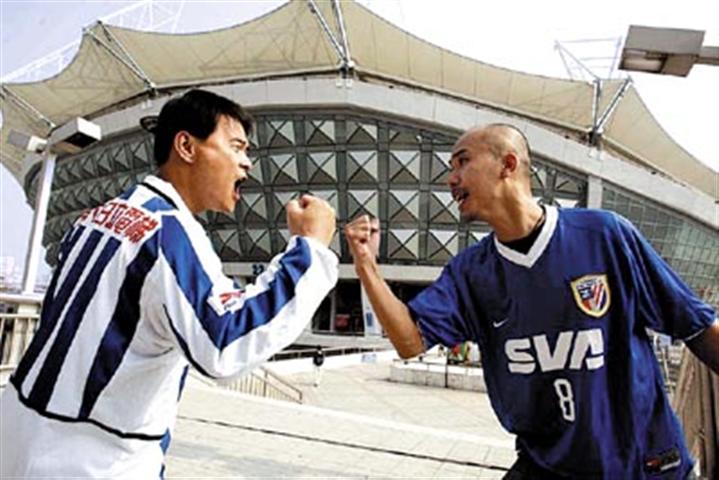
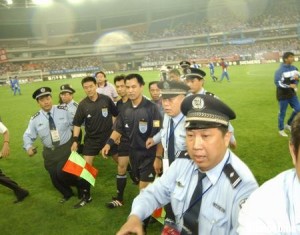
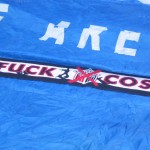

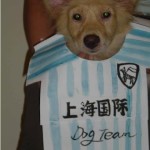
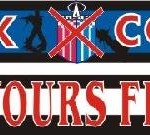
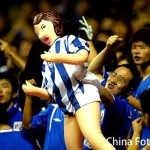
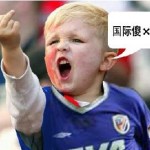
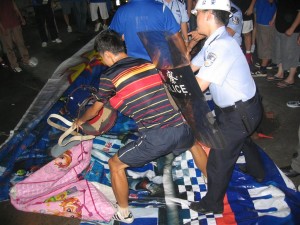
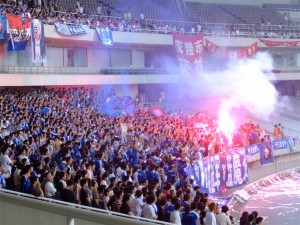
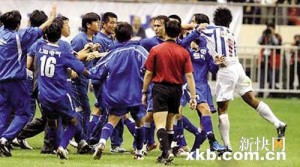
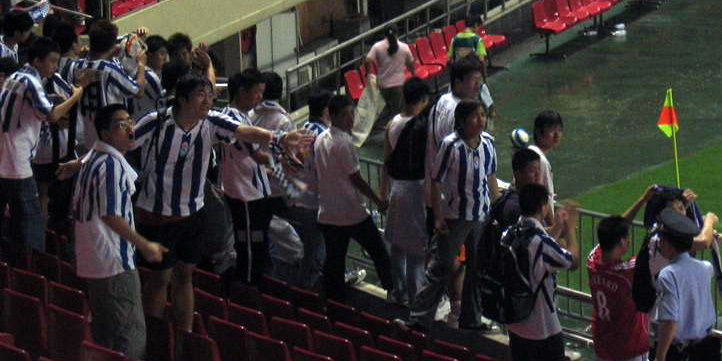
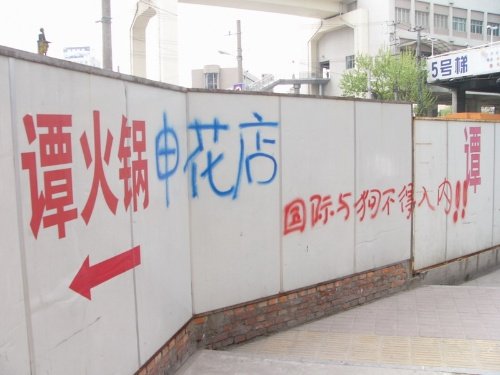
The best part of the graffiti’s the “No dogs or Inter can enter”….
As I’m always a pedant, I must mention that Shanghai Shenxin is a “home-grown rival” as the club was founded in Shanghai. Plus it has more locals than any other side and is the only one with a Shanghainese manager. Zhu Jiong add oil!
Not so pedantic B, those are relevant points. Unfortunately there wasn’t room to cover everything in this feature of epic length. Unfortunately for Shenxin they shit the bed as far as their Shanghai credentials go by leaving the city for many years. At least in Jinshan they had a catchment area to themselves and were getting decent crowds, it was senseless to move into Shanghai cty proper.
The Shanghai International Dog Team picture is a classic.